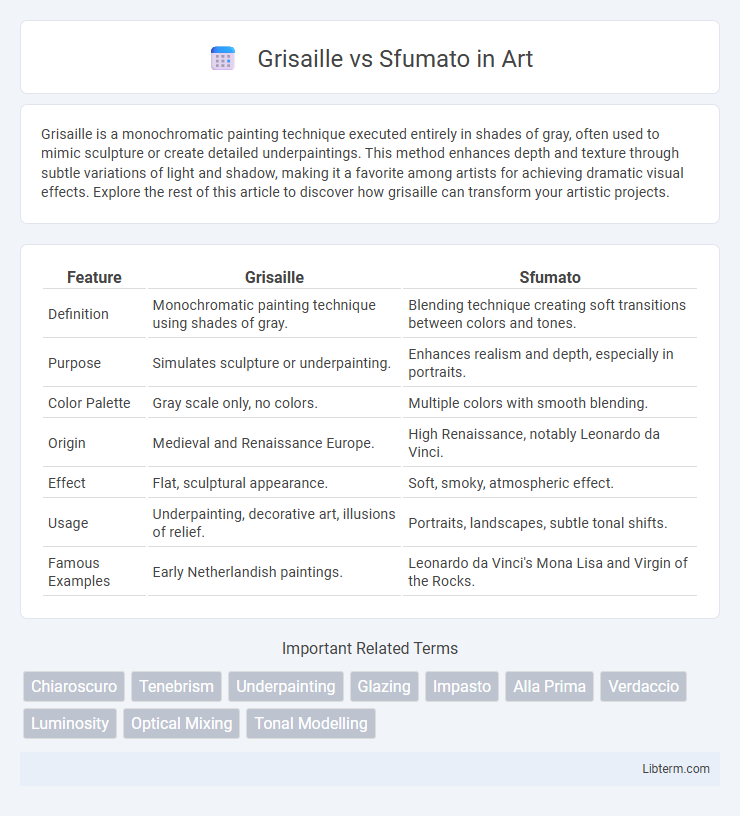Grisaille is a monochromatic painting technique executed entirely in shades of gray, often used to mimic sculpture or create detailed underpaintings. This method enhances depth and texture through subtle variations of light and shadow, making it a favorite among artists for achieving dramatic visual effects. Explore the rest of this article to discover how grisaille can transform your artistic projects.
Table of Comparison
| Feature | Grisaille | Sfumato |
|---|---|---|
| Definition | Monochromatic painting technique using shades of gray. | Blending technique creating soft transitions between colors and tones. |
| Purpose | Simulates sculpture or underpainting. | Enhances realism and depth, especially in portraits. |
| Color Palette | Gray scale only, no colors. | Multiple colors with smooth blending. |
| Origin | Medieval and Renaissance Europe. | High Renaissance, notably Leonardo da Vinci. |
| Effect | Flat, sculptural appearance. | Soft, smoky, atmospheric effect. |
| Usage | Underpainting, decorative art, illusions of relief. | Portraits, landscapes, subtle tonal shifts. |
| Famous Examples | Early Netherlandish paintings. | Leonardo da Vinci's Mona Lisa and Virgin of the Rocks. |
Introduction to Grisaille and Sfumato
Grisaille is a painting technique that uses shades of gray to create a monochromatic image, often employed to simulate sculpture or establish tonal values before adding color. Sfumato, developed during the Renaissance, involves the delicate blending of colors and tones to produce soft transitions and a smoky, atmospheric effect, famously used by Leonardo da Vinci. Both techniques enhance depth and dimensionality but differ fundamentally in approach: Grisaille emphasizes form through grayscale contrasts, while Sfumato focuses on subtle gradations and the absence of harsh lines.
Historical Origins and Development
Grisaille, originating in the Middle Ages, is a monochromatic painting technique using shades of gray to mimic sculpture and emphasize form through light and shadow, widely employed in Gothic and Renaissance art for devotional panels and underpaintings. Sfumato, developed during the High Renaissance by Leonardo da Vinci, involves delicate blending of colors and tones to produce soft transitions without harsh outlines, enhancing atmospheric depth and realism in portrait and landscape painting. Both techniques reflect distinct artistic goals: Grisaille emphasizes structural clarity and sculptural illusion, while Sfumato fosters nuanced, lifelike impressions through subtle tonal gradation.
Defining Grisaille: Technique and Purpose
Grisaille is a monochromatic painting technique executed entirely in shades of gray, designed to mimic the appearance of sculpture and emphasize form and volume through tonal variation. Frequently used for underpainting in oil painting, it establishes a detailed grayscale study that guides the application of color glazes. This method enhances depth and texture by relying solely on light and shadow without the distraction of color, allowing artists to focus on composition and structure.
Understanding Sfumato: Technique and Effect
Sfumato is a Renaissance painting technique characterized by the delicate blending of colors and tones, creating soft transitions without harsh lines. This method produces a smoky, atmospheric effect that enhances realism and depth in portraits by mimicking the subtle gradations of light and shadow on the human face. Unlike Grisaille, which uses monochromatic shades primarily for underpainting or sculptural illusion, Sfumato's focus lies in achieving lifelike softness and three-dimensionality through nuanced color modulation.
Key Artists Known for Grisaille
Grisaille, a monochromatic painting technique often executed in shades of gray, was notably employed by artists such as Jan van Eyck, Rogier van der Weyden, and Piero della Francesca for detailed underpaintings and trompe-l'oeil effects. In contrast, Sfumato, characterized by soft transitions and blurred edges, is famously associated with Leonardo da Vinci's masterpieces like the Mona Lisa and The Last Supper. Grisaille served as a foundational method for layering in Northern Renaissance art, highlighting precise form and volume through tonal variation rather than color.
Masters of Sfumato in Art History
Masters of sfumato such as Leonardo da Vinci revolutionized art with techniques that create soft transitions between colors and tones, producing lifelike and atmospheric effects. Unlike grisaille, which relies on monochromatic gray tones to simulate sculpture and form, sfumato uses subtle shading without harsh outlines to capture depth and realism. Leonardo's works, including the Mona Lisa and The Virgin of the Rocks, exemplify the mastery of sfumato, influencing countless artists in the Renaissance and beyond.
Visual Differences: Grisaille vs Sfumato
Grisaille uses monochromatic shades of gray to create a sculptural, three-dimensional effect with defined edges and clear contrasts between light and shadow. Sfumato employs soft, subtle gradations of tone and color, blending boundaries to produce a smoky, atmospheric effect without harsh lines. The visual difference lies in Grisaille's sharp, detailed monochrome imagery versus Sfumato's smooth, blurred transitions and muted color palette.
Artistic Effects and Mood Creation
Grisaille creates a monochromatic, sculptural effect emphasizing form and volume through shades of gray, often evoking a solemn, classical mood. Sfumato blends colors and tones seamlessly without harsh outlines, generating a soft, atmospheric haze that adds depth and a mysterious, ethereal ambiance. Both techniques manipulate light and shadow but differ in texture and emotional impact, with grisaille highlighting structure and sfumato enhancing emotional subtlety.
Applications in Contemporary Art
Grisaille, a monochromatic painting technique using shades of gray to create the illusion of sculpture, is often employed in contemporary art for underpainting and detailed studies that emphasize form and structure. Sfumato, characterized by its soft, blended transitions without harsh lines, is frequently applied in modern portraiture and abstract works to evoke atmosphere and emotional depth through subtle gradations of tone. Both techniques enhance contemporary compositions by offering distinct approaches to light, shadow, and texture, allowing artists to explore dimensionality and mood in innovative ways.
Choosing Between Grisaille and Sfumato
Choosing between grisaille and sfumato depends on the desired visual effect and technique in painting. Grisaille emphasizes monochromatic tones to create a sculptural, three-dimensional illusion using shades of gray, ideal for underpainting or achieving a classical, restrained aesthetic. Sfumato focuses on subtle blending of colors and soft transitions without harsh lines, producing a smoky, atmospheric effect popularized by Leonardo da Vinci for realistic depth and lifelike softness.
Grisaille Infographic

 libterm.com
libterm.com